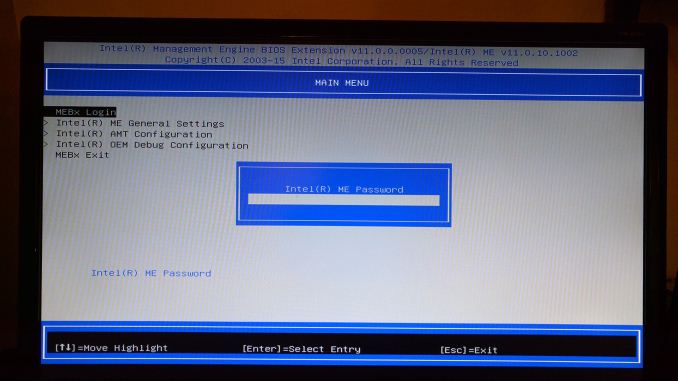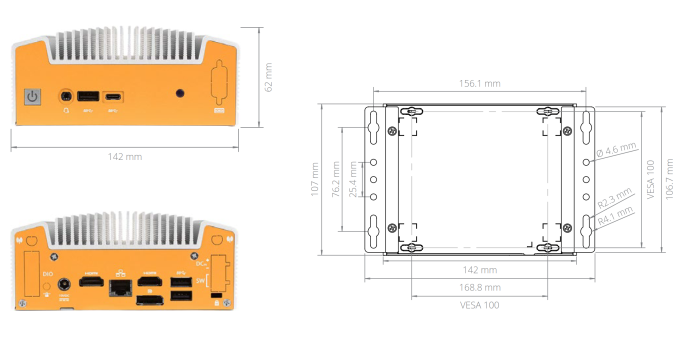Logic Supply ML100G-50 Fanless Skylake vPro Industrial NUC Review
by Ganesh T S on February 27, 2017 8:00 AM ESTMiscellaneous Aspects and Concluding Remarks
The primary selling point of the ML100G-50 is its vPro-capable Core i5-6300U. The only other Skylake industrial fanless PC that we have seen in this form factor is the Aleutia R50, but, that sports a Core i5-6260U and is not vPro-capable. In fact, the last vPro-capable fanless PC that we had evaluated was the Logic Supply ML100G-30. The Intel BIOS in it was very user-friendly, and had plenty of easy to understand options for configuring vPro and AMT. Unfortunately, the BIOS in the ML100G-50 is not as fancy as that of the Intel NUC or the ASRock Beebox, as shown in the gallery below.
Once the proper BIOS options under the Advanced > AMT Configuration were set up, Ctrl-P could be used to get into the ME BIOS. With the ML100G-30, we were able to configure the ME BIOS and set up remote access for administration. However, our ML100G-50 came with a locked ME BIOS password that we were unable to change.
We didn't take the trouble to get into the ME BIOS further, but, Intel's ME BIOS extensions are likely no different from what we saw in the ML100G-30 review.
In summary, Logic Supply has been able to deliver effectively on the promise of a fanless Skylake industrial PC. The chassis has been designed to adapt to the requirements of industrial PCs. The move from an Intel board to ASRock's Beebox NUC board delivers the best value for money (in terms of features such as multiple native display outputs, a USB 3.1 Gen 2 Type-C port etc.). The online ordering page provides plenty of options for customization.
Despite the excellent acoustics that come with being completely fanless and reasonable power consumption numbers, we do not recommend the unit as a passive HTPC. Simply put, the platform commands a premium for its vPro capabilities, and something like the Zotac ZBOX CI523 nano can deliver better value for money as a HTPC platform with the same capabilities.
In terms of scope for improvement, we have a spare SATA port on the board. The ability of the chassis to accommodate a 2.5" drive would be welcome, given that we have already sacrificed on the chassis height. We would also like Logic Supply to explore tweaks to the thermal design that can allow the CPU package to operate at the 20W package power level for a longer duration. Option to configure the unit with an integrated serial I/O port (something that is present in the ML100G-30) would also be welcome. Other than these minor quibbles, Logic Supply's ML100G-50 is a solid step up from the Broadwell-based ML100G-30.


















37 Comments
View All Comments
zepi - Monday, February 27, 2017 - link
Out of curiosity, what kind of ambient temperatures do you have in your test-bench?There is quite a difference between 18C and 28C room temperature in this kind of test.
bill.rookard - Monday, February 27, 2017 - link
Ideally you would think they would set ambient temp (via heat or a/c as needed) to a flat 21C/70F or so which is what most people would have as an average 'comfortable' temp. 28C might be a bit high (82F) while the 18C (64F) is a bit chilly.Although, considering these are 'industrial' type systems, you might actually subject them to a much wider dual temp test (15C/60F and 32C/90F) which you might find in a warehouse or factory floor.
zepi - Monday, February 27, 2017 - link
This is what I'm referring to. If someone deploys this at factory floor, temperature variations might be completely out of your standard AC'ed office block.Knowing ambiet temp would definitely help people estimating the dT figures that it can handle.
ganeshts - Monday, February 27, 2017 - link
The ambient temperature for all our thermal testing is between 70 and 74F.For one of our previous industrial PC reviews, I did the stress testing at multiple temperature points - http://www.anandtech.com/show/6494/aleutia-relia-i... , but the overall feedback in terms of balance between time spent on a review and actionable results was that room temperature testing is more than enough.
If the customer is ordering, say, 20K or 30K worth of these PCs, I am sure Logic Supply would be more than happy to deliver those graphs for the particular workloads to be used at different temperature points [ just my opinion :) ]
Samus - Tuesday, February 28, 2017 - link
The issue I think he is raising is the typical ambient temperature of a ventilated kiosk or summertime warehouse is probably 90F. Who knows how high it is when not ventilated. For a review of an industrial PC, it would probably be appropriate to increase your ambient temp to real-world scenarios.SkipPerk - Wednesday, April 19, 2017 - link
Our facilities routinely top 105 in August. I had to use a laptop cooler to keep my Asus ultrabook from slowing down excessively. I updated both required PC's to large CPU coolers (Noctua NH-12) and filled every fan slot (plus we ALWAYS use dust filters or else the motherboards get so dusty that when it gets humid they short out on wet dust).Temperature is a valid question. I have seen boxes in digital signage that get insanely hot (think 130 degrees F). You not only need fans, but you want to ventilate the box the computer is in. An old server Delta fan for an intake and an outtake will drop an enclosure down to five or ten degrees above ambient.
Outside temps matter considerably in the summer. As does humidity.
Meteor2 - Monday, February 27, 2017 - link
I think most people go for 19 C these days if using heating. Uses 20% less energy than 21 C.eldakka - Monday, February 27, 2017 - link
At least for this product being tested, the specifications from their website are:Operating Temperature Range 0°C ~ 50°C
Therefore, in theory at least, any ambient temperature likely to be found inside a livable room should be satisfactory for this device.
Can't speak for the other devices like the ECS or Zotac machines tho.
Ro_Ja - Monday, February 27, 2017 - link
It looks like a big heat sink itself.tipoo - Monday, February 27, 2017 - link
It is. It's fanless, uses the whole case as a heatsink.